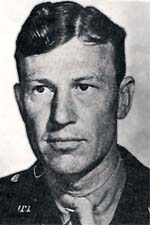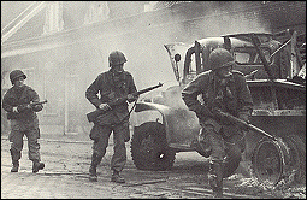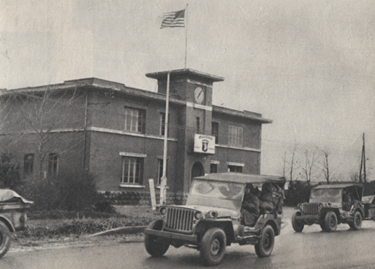 |
501st Parachute Infantry (PIR) History |
 |
The 501st Parachute Infantry Regiment (501st PIR) was activated in Toccoa, Georgia in November 1942 where the young paratroopers to be were given basic Infantry training. In May 1943 they earned their jump wings at Fort Benning. Shortly after Jump School and throughout the summer the Regiment undertook Company, Battalion and Regimental training at Camp MaCall, North Carolina, and participated in the Tennessee maneuvers.
 The
501stPIR, commanded by Colonel Howard Johnson (Jumpy Johnson), was attached
to the 101st Airborne Division just before the Regiment departed for
England in December of 1943. They made their first jump into Normandy
in the early morning hours of D-Day, June 6, 1944. In July of '44 the
Regiment returned from Normandy and began to re-fit and train for the
next operation.
The
501stPIR, commanded by Colonel Howard Johnson (Jumpy Johnson), was attached
to the 101st Airborne Division just before the Regiment departed for
England in December of 1943. They made their first jump into Normandy
in the early morning hours of D-Day, June 6, 1944. In July of '44 the
Regiment returned from Normandy and began to re-fit and train for the
next operation.
After several false starts the 501st PIR, along with the entire 101st Airborne, was alerted for Operation Market Garden Holland on September 17, 1944.
On 17 September 1944 Operation Market Garden, Montgomery's ambitious plan to perform an end run around the retreating German Army, began with the largest Airborne operation in history.
 As
part of the 101st Airborne the 501st Parachute Infantry Regiment parachuted
near the town of Veghel, 25 miles behind the German front lines. The
501st was specifically tasked to drop 4 miles south of Veghel and seize
railroad and highway bridges over the Aa River and the Willems Canal.
Though Lt Colonel Kinnard's 1st Battalion landed wide of their mark,
they landed all together and were were quickly able to seize two railroad
bridges to the west of Veghel. Meanwhile, the other two battalions were
able to seize intact the road bridges over the Willems Canal and Aa
River. The result was the rapid taking of one of the first major barriers
on the route of Montgomery's Second British Army to Arnhem.
As
part of the 101st Airborne the 501st Parachute Infantry Regiment parachuted
near the town of Veghel, 25 miles behind the German front lines. The
501st was specifically tasked to drop 4 miles south of Veghel and seize
railroad and highway bridges over the Aa River and the Willems Canal.
Though Lt Colonel Kinnard's 1st Battalion landed wide of their mark,
they landed all together and were were quickly able to seize two railroad
bridges to the west of Veghel. Meanwhile, the other two battalions were
able to seize intact the road bridges over the Willems Canal and Aa
River. The result was the rapid taking of one of the first major barriers
on the route of Montgomery's Second British Army to Arnhem.
The 501st, along with the rest of the division, moved from initial objective areas to positions on "the island" between the Waal and Rhine Rivers. It became clear that they would not be withdrawn from Holland after a few days, as had been planned because their combat skills were sorely needed by the British. However, the prolonged fighting on "the island" was contrary to airborne tactics and strategy. After the initial hard fighting it became a static war of patrolling and attrition, principally by artillery and mortars.
One such mortar attack, near Heteren, on 8 October
1944, fatally wounded Colonel Johnson. As he was being evacuated, his
last words to Lt Colonel Ewell were, "Take care of my boys"
son bridge.
In late November 1944, the 101st division was returned
to France to receive replacements, re-train, re-equip and prepare for
additional operations after the new year. Three weeks after arriving
at Camp Mourmelon, France the Germans launched the offensive in the
Belgian region known as the Ardennes, the Battle of the Bulge had begun. The 101st Airborne was alerted and within hours was jammed into trucks
and rushing through the night to the town of Bastogne, Belgium arriving
in the predawn morning of Dec. 18th. The 501st PIR was the first unit
to arrive and moved through the town as dawn broke to meet the approaching
German's three miles beyond the town. The Regiment fought the enemy
to a stand still and held kept the Germans at bay until the rest of
the division could arrive.
The 101st Airborne was alerted and within hours was jammed into trucks
and rushing through the night to the town of Bastogne, Belgium arriving
in the predawn morning of Dec. 18th. The 501st PIR was the first unit
to arrive and moved through the town as dawn broke to meet the approaching
German's three miles beyond the town. The Regiment fought the enemy
to a stand still and held kept the Germans at bay until the rest of
the division could arrive.
The 101st Airborne Division, "Battered Bastards of Bastogne " fought off elements of seven German divisions before Patton broke through the encirclement on December 26th.
On January 20, 1945 "Operation Nordwind", the last offensive action by the Germans during WWII was launched. The 101st Airborne, tattered and worn from fighting in the "Bulge" was rushed to Alsace to bolster the defense of the Seventh Army. The 501st PIR, of only 60% strong, occupied defensive positions there until returning to Camp Mourmelon, France early in March 1945.
As the war in Europe was nearing its end, the 101st division was sent to the Ruhr pocket to help in mop-up operations. The 501st remained in France, preparing to jump on Prisoner Of War camps if necessary to rescue and free American POW's.
In August 1945 the regiment was detached from the 101st and sailed for home to be deactivated at Fort Benning, Georgia.
In the course of the three campaigns through January 14 1945, 517 paratroopers of the regiment were killed or died of wounds in action, 1639 were wounded or injured, and 328 were captured or missing, according to the 101'st Airborne Division History, "Rendezvous with Destiny".
501st Parachute Infantry Regiment Awards and Decorations
The 501st Parachute Infantry Regiment (PIR) received the following Awards and Decorations for distinguished performance on the battlefields of Europe.
| United States |
| Two Presidential Distinguished Unit Citations for operations in Normandy and Bastogne. |
| France |
| The Croix de Guerre with Palm for operations in Normandy. |
| Belgium |
| Two Croix de Guerre and one Fourragere for operations at Bastogne |
| Netherlands |
| Netherlands Orange Lanyard for operations in The Netherlands |